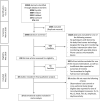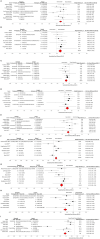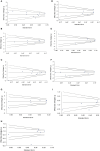Evaluation of Wearable Technology in Dementia: A Systematic Review and Meta-Analysis
- PMID: 33505979
- PMCID: PMC7829192
- DOI: 10.3389/fmed.2020.501104
Evaluation of Wearable Technology in Dementia: A Systematic Review and Meta-Analysis
Erratum in
-
Corrigendum: Evaluation of Wearable Technology in Dementia: A Systematic Review and Meta-Analysis.Front Med (Lausanne). 2021 Mar 11;8:659639. doi: 10.3389/fmed.2021.659639. eCollection 2021. Front Med (Lausanne). 2021. PMID: 33777985 Free PMC article.
Abstract
Background: The objective of this analysis was to systematically review studies employing wearable technology in patients with dementia by quantifying differences in digitally captured physiological endpoints. Methods: This systematic review and meta-analysis was based on web searches of Cochrane Database, PsycInfo, Pubmed, Embase, and IEEE between October 25-31st, 2017. Observational studies providing physiological data measured by wearable technology on participants with dementia with a mean age ≥50. Data were extracted according to PRISMA guidelines and methodological quality assessed independently using Downs and Black criteria. Standardized mean differences between cases and controls were estimated using random-effects models. Results: Forty-eight studies from 18,456 screened abstracts (Dementia: n = 2,516, Control: n = 1,224) met inclusion criteria for the systematic review. Nineteen of these studies were included in one or multiple meta-analyses (Dementia: n = 617, Control: n = 406). Participants with dementia demonstrated lower levels of daily activity (standardized mean difference (SMD), -1.60; 95% CI, -2.66 to -0.55), decreased sleep efficiency (SMD, -0.52; 95% CI, -0.89 to -0.16), and greater intradaily circadian variability (SMD, 0.46; 95% CI, 0.27 to 0.65) than controls, among other measures. Statistical between-study heterogeneity was observed, possibly due to variation in testing duration, device type or patient setting. Conclusions and Relevance: Digitally captured data using wearable devices revealed that adults with dementia were less active, demonstrated increased fragmentation of their sleep-wake cycle and a loss of typical diurnal variation in circadian rhythm as compared to controls.
Keywords: cognition; geriatrics; sleep; technology; wearable.
Copyright © 2021 Cote, Phelps, Kabiri, Bhangu and Thomas.
Conflict of interest statement
The authors declare that the research was conducted in the absence of any commercial or financial relationships that could be construed as a potential conflict of interest.
Figures




Similar articles
-
Using Google Glass in Nonsurgical Medical Settings: Systematic Review.JMIR Mhealth Uhealth. 2017 Oct 19;5(10):e159. doi: 10.2196/mhealth.8671. JMIR Mhealth Uhealth. 2017. PMID: 29051136 Free PMC article.
-
Wearable sensors for monitoring caregivers of people with dementia: a scoping review.Eur Geriatr Med. 2025 Apr;16(2):473-483. doi: 10.1007/s41999-024-01113-8. Epub 2024 Dec 3. Eur Geriatr Med. 2025. PMID: 39625554 Free PMC article.
-
Actigraphy for evaluation of mood disorders: A systematic review and meta-analysis.J Affect Disord. 2019 Jun 15;253:257-269. doi: 10.1016/j.jad.2019.04.087. Epub 2019 Apr 22. J Affect Disord. 2019. PMID: 31060012
-
Patient acceptability of wearable vital sign monitoring technologies in the acute care setting: A systematic review.J Clin Nurs. 2019 Aug;28(15-16):2732-2744. doi: 10.1111/jocn.14893. Epub 2019 May 9. J Clin Nurs. 2019. PMID: 31017338
-
The effect of yoga on sleep quality and insomnia in women with sleep problems: a systematic review and meta-analysis.BMC Psychiatry. 2020 May 1;20(1):195. doi: 10.1186/s12888-020-02566-4. BMC Psychiatry. 2020. PMID: 32357858 Free PMC article.
Cited by
-
Using Apple Watches to Monitor Health and Behaviors of Individuals With Cognitive Impairment: A Case Series Study.J Gerontol A Biol Sci Med Sci. 2025 Mar 7;80(4):glae250. doi: 10.1093/gerona/glae250. J Gerontol A Biol Sci Med Sci. 2025. PMID: 39478338
-
Homing wellness: can narrative design transform living spaces for people with dementia into engaging environments enabling communication?Front Public Health. 2024 Jan 15;11:1198253. doi: 10.3389/fpubh.2023.1198253. eCollection 2023. Front Public Health. 2024. PMID: 38292379 Free PMC article.
-
How do care home staff use non-pharmacological strategies to manage sleep disturbances in residents with dementia: The SIESTA qualitative study.PLoS One. 2022 Aug 9;17(8):e0272814. doi: 10.1371/journal.pone.0272814. eCollection 2022. PLoS One. 2022. PMID: 35944055 Free PMC article.
-
Wearable Sensors in Other Medical Domains with Application Potential for Orthopedic Trauma Surgery-A Narrative Review.J Clin Med. 2024 May 27;13(11):3134. doi: 10.3390/jcm13113134. J Clin Med. 2024. PMID: 38892844 Free PMC article. Review.
-
Alzheimer's in the modern age: Ethical challenges in the use of digital monitoring to identify cognitive changes.Inform Health Soc Care. 2024 Jan 2;49(1):1-13. doi: 10.1080/17538157.2023.2294203. Epub 2023 Dec 20. Inform Health Soc Care. 2024. PMID: 38116960 Free PMC article.
References
-
- Alzheimer's Disease International (ADI) . Dementia: a Public Health Priority. World Health Organization; (2013).
Publication types
LinkOut - more resources
Full Text Sources
Other Literature Sources
Miscellaneous

